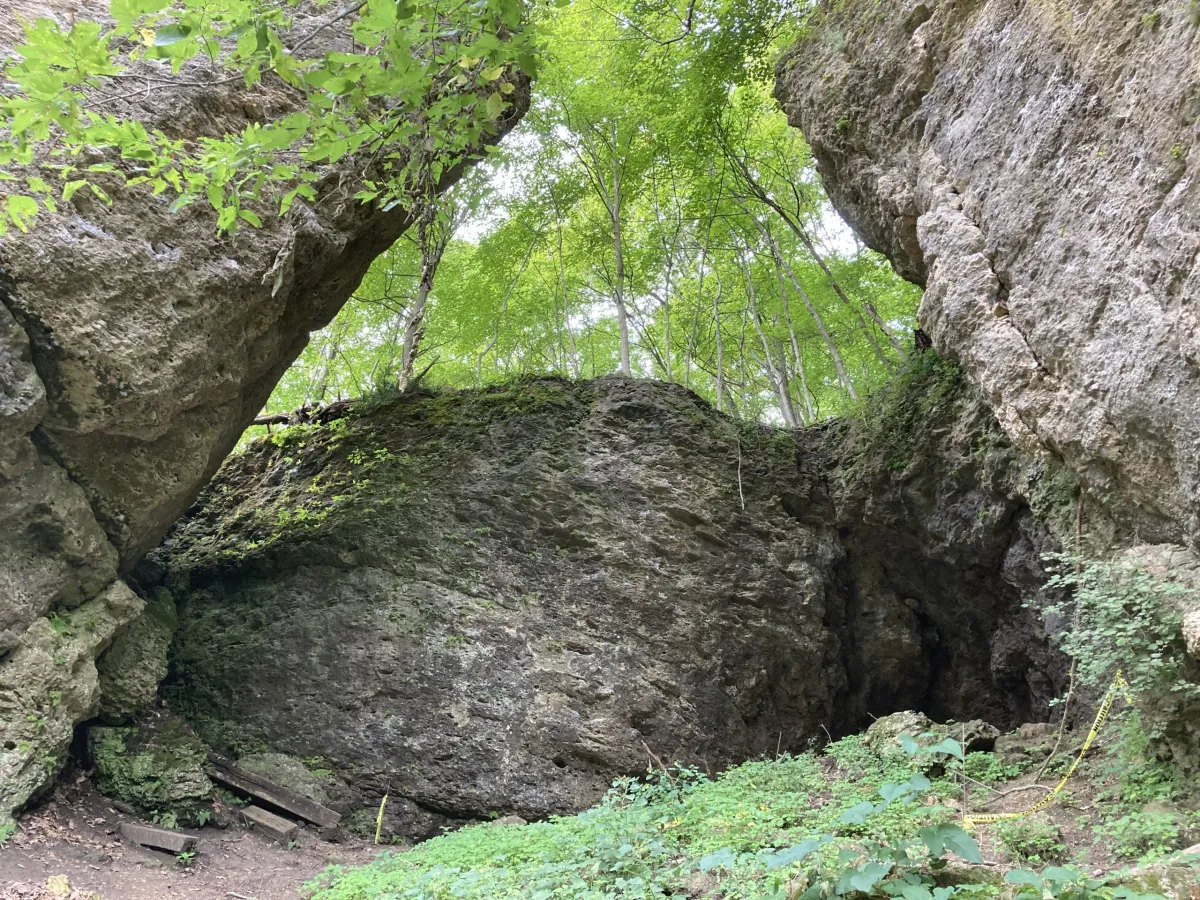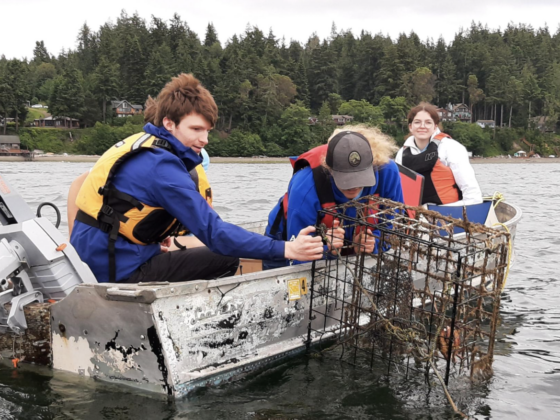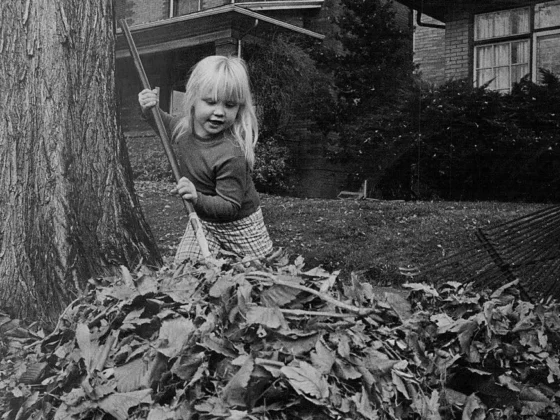Editor’s note: Since 2007, The Daily Yonder has been telling the rich and complex stories of rural America, in contrast to the familiar one-story-fits-all versions. The Our Towns team has been long-time admirers of The Daily Yonder’s work, and we are excited to have begun sharing some of their reporting on the Our Towns website, which we first started doing here, and here.
An area of focus at Our Towns has been to tell the stories of how people are addressing sustainability and environmental issues, both the challenges and opportunities they face, at the local level. We feature those reports here.
In this original report, Rachel Cramer describes how a county park and a climbing coalition are collaborating to maintain access to a popular recreational area amid an uptick of users while preserving the environment to meet conservation goals. What is happening in Iowa serves as a good reference point for other parks and coalitions nationwide.
A Delicate Balance – Marrying Recreation and Preservation in Iowa
Over the last two decades, many of America’s public lands and waters have experienced a significant increase in visitation. Outdoor gear that’s lighter and more comfortable, smartphones with GPS and Instagram, remote work and migration to rural “recreation counties” have all played a role.
But the uptick, along with a proliferation of ways to recreate outdoors, can make it challenging for land managers trying to balance conservation goals with the needs and priorities of different user groups. Ongoing collaborations between a county park and climbing coalition in the Hawkeye State may offer some guidance.
The view through the windshield looks like much of eastern Iowa – rolling hills carpeted in corn and soybeans, trees clustered around farm houses. But then, the edge of a forest appears. A dense canopy of oak and hickory submerges the road in shade as it drops toward the Maquoketa River.
For many, the limestone bluff faces, pockmarked and dotted with fossilized sea creatures, are the main attraction at Pictured Rocks County Park. That includes a small but growing number of outdoor climbers.

Next to a dozen cars in the parking lot, Raud Kashef, Iowa Climbers Coalition (ICC) board member, and ICC volunteer Daniela Peerret sling backpacks over their shoulders and lead two new climbers down the trail.
“I’ve been coming here for the last nine years,” said Kashef. “I’m still learning more about the park and seeing things I didn’t see before. Some rock faces I’ve looked at hundreds of times; I’ll go out and see a different way a route could be climbed.”
They wind their way through the green understory, greeting other climbers, many by name. At the base of one of the walls, Peerret ties a rope into her harness and dusts her hands with chalk. She says she got into climbing at the start of the Covid-19 pandemic.
“I love that it’s a full body experience. You have to think about every little finger and toe; it’s a balance and you can’t think about anything else because you don’t want to fall,” said Peerret. “It’s almost meditative because you have to be super focused.”
Pictured Rocks has over 60 bolted routes, plus areas designated for other types of climbing like bouldering. The easy access and unique karst geology have made it one of the most popular places for outdoor climbing in Iowa and regularly draws climbers from neighboring Wisconsin and Illinois.
But in the late 90s and early 2000s, the future of rock climbing at the county park, as well as the surrounding wildlife management area, was tenuous.

John Klein is a ranger and operations manager for Jones County Conservation, which manages Pictured Rocks under an agreement with the Iowa Department of Natural Resources.
“The state and local government entities knew [rock climbing] was going on, but they didn’t talk about it because they didn’t really know how to manage it and weren’t sure how big it would become,” said Klein. “On the climbing side, climbers didn’t really want to talk about it either. I think, in their mind, they were afraid the government was going to regulate it and that it wouldn’t be fun anymore.”
When Klein joined Jones County Conservation 25 years ago, climbers were forming their own trails and drilling hardware into the bluff faces without permission.
“We did a count, and there were 300 anchors in the Pictured Rocks area. Anchors weren’t being maintained to a level we thought was the right level of management on public ground. They weren’t being inspected and replaced on an annual basis.”
Klein and his team were also worried about erosion in areas with endangered and threatened species, and certain groups felt like the climbers shouldn’t be there, especially in wildlife management areas paid in part by hunting and angling license fees and excise taxes on equipment.
With the possibility of rock climbing no longer being allowed, the newly formed ICC started meeting with Klein and the DNR district biologist. They talked through their concerns and priorities, eventually developing a management plan to keep climbing within the goals of conservation.
While no new routes can be added to the wildlife management area under the current plan, the ICC may submit up to eight applications per year to add routes within the 79-acre county park. The application includes information about the location of the proposed route, the types of bolts that would be used and where they’d be attached to the rock face. An advisory committee then reviews the application and determines whether climbing is a compatible use for the site.

Kashef says the coalition tries to add routes based on community needs. If there are a lot of climbers waiting around a particular route, ICC may look for another location that would offer a similar experience.
But he says not every route that can be climbed, should be climbed.
“If we don’t feel like the trail and staging area can be sustained – if we feel like the soil would erode if there was too much foot traffic – then we won’t propose to develop routes there.”
As part of the management plan with Jones County, ICC also inspects and replaces old climbing hardware each year and helps with trail maintenance.
Near a popular climbing area known as the Comic Gallery, Kashef points out stone stairs and retaining walls leading up to a cave. This summer, around 50 ICC volunteers moved 45 tons of stone – mostly with wheelbarrows and rock nets – to stabilize the slope and create safer belay areas.
Since a previous archaeological study indicated the cave was used by Indigenous people moving through the river corridor, the State Historic Preservation Office reviewed the trail improvement plan developed by ICC and Jones County Conservation before any work was done.
Access Fund, a national nonprofit advocacy organization that aims to conserve climbing areas and keep them open to the public, provided two trail building experts and equipment to help with the project. The nonprofit also awarded ICC a grant to help cover its half of the $20,000 bill from the local stone quarry. Jones County Conservation funded the rest.
Ty Tyler, Access Fund’s Stewardship Director, focuses on the long-term sustainability of climbing areas across the U.S. That includes working with climbing coalitions and land managers ranging from federal agencies, like the U.S. Forest Service and Bureau of Land Management, to city government on recreation planning for climbing.
According to a report from the Outdoor Foundation, around 2.3 million people in the U.S. engaged in outdoor sport climbing and bouldering in 2020. But many land management plans were developed decades ago when climbing was more of a niche activity.
“[Land managers] generally view climbers as good stewards and good users of public land, but I think at the same time, because of the exponential growth in climbers … land managers are kind of struggling with that ramp-up and how to manage that recreation when they haven’t had to historically when it was relatively small numbers,” said Tyler.

He emphasized one of the benefits of the more than 100 climbing coalitions in the U.S., like ICC, is that they can pull people together around a common goal or project and serve as a point-of-contact for land managers. Coalitions can also take some pressure off agencies with limited resources by bringing money and volunteer hours to the table and provide a different perspective to recreation planning around climbing areas.
“At the base of a climb, there may be a group [of climbers], the rope bag and gear, a dog – and then if you’re belaying a lead climber, you move out away from the base, so that’s why our staging areas get wider and wider.”
By understanding how climbers use the base of a climb and why certain routes are more popular than others, coalitions like ICC can help identify ways to reduce impacts on a landscape, said Tyler.
At Pictured Rocks, Klein echoed this idea, saying, “The ICC, the climbing community are the experts in their field, and we wanted to incorporate that expertise as long as climbing was going to be allowed to take place. You want to build those partnerships and show that teamwork can happen.”
With the proliferation of indoor climbing gyms, movies about professional climbers, and the recent debut at the Olympics, climbing is expected to become more mainstream and a bigger part of recreation on public lands. Success at places like Pictured Rocks County Park highlight how coalitions and land managers can work together to balance recreation and conservation.
This article first appeared on The Daily Yonder and is republished here under a Creative Commons license.




